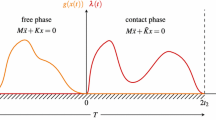Abstract
This article proposes a simple linear-by-part approach for perfectly elastic 3D multiple-point impacts in multibody systems with perfect constraints and no friction, applicable both to nonredundant and redundant cases (where the normal velocities of the contact points are not independent). The approach is based on a vibrational dynamical model, and uses the so called “independent contact space.” Two different time and space scales are used. At the macroscale, the impact interval is negligible, and the overall system configuration is assumed to be constant. Consequently, the inertia and Jacobian matrices appearing in the formulation are also constant. The dynamics at the contact points is simulated through stiff springs undergoing very small deformations and generating system vibrations at the microscale. The total impact interval is split into phases, each corresponding to a constant set of compressed springs responsible for an elastic potential energy. For each phase, a reduced inertia matrix associated with a set of contact points, and a reduced stiffness matrix obtained from the potential energy (associated with all contact points undergoing compression) are introduced. From these matrices, a modal analysis is performed yielding an all-analytical solution within each phase. The main difference between the redundant and nonredundant cases concerns the inertia and stiffness matrices for modal analysis. While in the former case, both are related to the total set of contact points (total contact space), in the latter one they are related to two subsets: a subset of independent points for the inertia matrix (independent contact space), and the total set for the stiffness matrix. A second difference concerns the calculation of the normal impulses generated at each contact point. For the nonredundant case, they can be directly obtained from the total incremental normal velocities of the contact points through the inertia and stiffness matrices. For the redundant one, they can be obtained by adding up their incremental values at each impact phase. This requires an updating of a new effective stiffness matrix depending on the contact points undergoing compression at each phase. Four planar application cases are presented involving a single body and a multibody system colliding with a smooth ground.






Similar content being viewed by others
References
Schiehlen, W., Seifried, R., Eberhard, P.: Elastoplastic phenomena in multibody impact dynamics. Comput. Methods Appl. Mech. Eng. 195, 6874–6890 (2006). doi:10.1016/j.cma.2005.08.011
Gilardi, G., Sharf, I.: Literature survey of contact dynamics modelling. Mech. Mach. Theory 37, 1213–1239 (2002). doi:10.1016/S0094-114X(02)00045-9
Agulló, J., Barjau, A.: Rough impacts in multibody systems. Mech. Mach. Theory 26(6), 565–577 (1991). doi:10.1016/0094-114X(91)90039-7
Liu, C., Zhao, Z., Brogliato, B.: Frictionless multiple impacts in multibody systems. I. Theoretical framework. Proc. R. Soc. A, Math. Phys. Eng. Sci. 464, 3193–3211 (2008). doi:10.1098/rspa.2008.0078
Newby, N.D.: Linear impacts with harmonic oscillator forces: the inverse scattering forces. Am. J. Phys. 47(2), 161–165 (1979)
Acary, V., Brogliato, B.: Concurrent multiple impacts modelling: case study of a 3-ball chain. In: Bathe, K.J. (ed.) Proc. MIT Conf. on Computational Fluid and Solid Mechanics, pp. 1836–1841. Elsevier Science, Amsterdam (2003)
Acary, V., Taha, D.E.: Concurrent multiple impacts in rigid bodies: formulation and simulation. In: Fifth Euromech Nonlinear Dynamics Conference, ENOC, Eindhoven University of Technology, Eindhoven, Pays-Bas. Springer, Berlin (2005)
Jia, Y.-B., Mason, M.T., Erdmann, M.A.: Multiple impacts: a state transition diagram approach. Int. J. Robot. Res. 32(1), 84–114 (2013). doi:10.1177/0278364912461539
Yilmaz, C., Gharib, M., Hurmuzlu, Y.: Solving frictionless rocking block problem with multiple impacts. Proc. R. Soc. A 465, 3323–3339 (2009). doi:10.1098/rspa.2009.0273
Poisson, S.D.: Traité de Mécanique. Bachelier, Imprimeur, vol. 2. Librairie, Paris (1983)
Delunay, Ch.: Traité de Mécanique Rationelle. Livre IV: Dinamique, troisième partie. Langlois and Leclerq, Victor Masson, Paris (1856)
Résal, H.: Traité de Mecanique Générale. Tome VII: Développements sur la Mécanique Rationelle et la Cinématique Pure. Gautier-Villars, Paris (1889)
Boulanger, G.: Note sur le choc avec frottement des corps non parfaitement élastiques. Rev. Sci. 5, 325–327 (1939)
Brogliato, B.: Nonsmooth impact mechanics: models, dynamics and control. In: Lecture Notes in Control and Information Sciences, p. 220. Springer, Berlin (1996)
Stronge, W.J.: Impact Mechanics. Cambridge University Press, Cambridge (2000)
Brogliato, B., Zhang, H., Liu, C.: Analysis of a generalized kinematic impact law for multibody-multicontact systems, with application to the planar rocking block and chains of balls. Multibody Syst. Dyn. 27, 351–382 (2012). doi:10.1007/s110044-012-9301-3
Batlle, J.A.: On Newton’s and Poisson’s rules of percussive dynamics. J. Appl. Mech. 60, 376–381 (1993). doi:10.1115/1.2900804
Bowling, A., Flickinger, D.M., Harmeyer, S.: Energetically consistent simulation of simultaneous impacts and contacts in multibody systems with friction. Multibody Syst. Dyn. 22, 27–45 (2009). doi:10.1007/s511044-009-9147-5
Ruspini, D.C., Khatib, O.: Impact/contact models for the dynamic simulation of complex environments. In: Proc. IEEE/RSJ Int. Conf. on Intelligent Robots and Systems (1997)
Mirtich, B., Canny, J.: Impulse-based simulation of rigid bodies. In: Proc. of the 1995 Symposium on Interactive 3D Graphics (1995). doi:10.1145/199404.199436
Glocker, C., Pfeiffer, F.: Multiple impacts with friction in rigid multibody systems. J. Nonlinear Dyn. 7, 471–497 (1995). doi:10.1007/BF00121109
Caselli, F., Frémond, M.: Impact of three balls on a plane. Comput. Mech. 43, 743–754 (2009). doi:10.1007/s00466-008-0342-7
Johansson, L.: A Newton method for rigid body frictional impact with multiple simultaneous impact points. Comput. Methods Appl. Mech. Eng. 191, 239–254 (2001). doi:10.1016/S0045-7825(01)00272-9
Ruspini, D.C., Khatib, O.: A framework for multi-contact multi-body dynamic simulation and haptic display. In: Proc. IEEE/RSJ Int. Conf. on Intelligent Robots and Systems, vol. 2, pp. 1322–1327 (2000). doi:10.1109/IROS.2000.893204
Moreau, J.J.: Some numerical methods in multibody dynamics: application to granular materials. Eur. J. Mech. A, Solids 13(4), 93–114 (1994)
Kövecses, J.: Dynamics of mechanical systems and the generalized free-body diagram—part I: general formulation. J. Appl. Mech. 75, 061012 (2008). doi:10.1115/1.2965372
Constantinescu, D., Salcudean, S.E., Croft, E.A.: Haptic rendering of rigid body impacts. In: Proc. 12th Int. Symposium HAPTICS’04, pp. 2–8 (2004). doi:10.1109/HAPTIC.2004.1287171
Author information
Authors and Affiliations
Corresponding author
Rights and permissions
About this article
Cite this article
Barjau, A., Batlle, J.A. & Font-Llagunes, J.M. Combining vibrational linear-by-part dynamics and kinetic-based decoupling of the dynamics for multiple smooth impacts with redundancy. Multibody Syst Dyn 31, 497–517 (2014). https://doi.org/10.1007/s11044-013-9398-z
Received:
Accepted:
Published:
Issue Date:
DOI: https://doi.org/10.1007/s11044-013-9398-z




